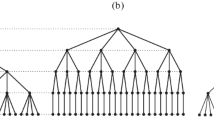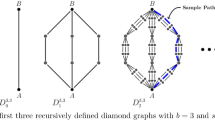Abstract
In the quantum Efimov effect, identical bosons form infinitely many bound trimer states at the bound dimer dissociation threshold, with their energy spectrum obeying a universal geometrical scaling law. Inspired by the formal correspondence between the possible trajectories of a quantum particle and the possible conformations of a polymer chain, the existence of a triple-stranded DNA bound state when a double-stranded DNA is not stable was recently predicted by modelling three directed polymer chains in low-dimensional lattices, both fractal (\(d<1\)) and euclidean (\(d=1\)). A finite melting temperature for double-stranded DNA requires in \(d\le 2\) the introduction of a weighting factor penalizing the formation of denaturation bubbles, that is non-base paired portions of DNA. The details of how bubble weighting is defined for a three-chain system were shown to crucially affect the presence of Efimov-like behaviour on a fractal lattice. Here we assess the same dependence on the euclidean \(1+1\) lattice, by setting up the transfer matrix method for three infinitely long chains confined in a finite size geometry. This allows us to discriminate unambiguously between the absence of Efimov-like behaviour and its presence in a very narrow temperature range, in close correspondence with what was already found on the fractal lattice. When present, however, no evidence is found for triple-stranded bound states other than the ground state at the two-chain melting temperature.





Similar content being viewed by others
Notes
The mapping of bubble weighting onto the quantum formalism might be possible by introducing a tunnelling coefficient through a \(\delta \)-potential barrier at the boundary of a short-range square well. Hermiticity would, however, require both the opening and the closing of bubbles to be given the same weight.
The value of the reunion exponent c is related to the order of the melting transition of double-stranded DNA and was computed for a fully self-avoiding (i.e. non-directed) \(d=3\) polymer model [19]. The values of the reunion exponent for several directed polymers are known exactly in \(d=1\) [21] and through renormalization group estimates in generic dimension [22].
At the melting transition, the two-chain problem is equivalently described by a fully unbiased (\(y=1\), \(\sigma =1\)) random walk, thus yielding a uniform probability distribution at equilibrium in a finite size system with periodic boundary conditions
References
V. Efimov, Phys. Lett. B 33, 563 (1970)
E. Braaten, H.-W. Hammer, Ann. Phys. 322, 120 (2007)
D.V. Fedorov, A.S. Jensen, K. Riisager, Phys. Rev. Lett. 73, 2817 (1994)
T. Kraemer, M. Mark, P. Waldburger, J.G. Danzl, C. Chin, B. Enseger, A.-D. Lange, K. Pilch, A. Jaakkola, H.-C. Nägerl, R. Grimm, Nature 440, 315 (2006)
J. Maji, S.M. Bhattacharjee, F. Seno, A. Trovato, New J. Phys. 12, 083057 (2010)
J. Maji, S.M. Bhattacharjee, Phys. Rev. E 86, 041147 (2012)
T. Pal, P. Sadhukhan, S.M. Bhattacharjee, Phys. Rev. Lett. 110, 028105 (2013)
J. Maji, S.M. Bhattacharjee, F. Seno, A. Trovato, Phys. Rev. E 89, 012121 (2014)
T. Pal, P. Sadhukhan, S.M. Bhattacharjee, Phys. Rev. E 91, 042105 (2015)
D. Poland, H.A. Scheraga, J. Chem. Phys. 85, 1456 (1966)
M.D. Frank-Kamenetskii, S.M. Mirkin, Annu. Rev. Biochem. 64, 65 (1995)
I. Radhakrishnan, D.J. Patel, Biochemistry 33, 11405 (1994)
E.N. Nikolova, F.L. Gottardo, H.M. Al-Hashimi, J. Am. Chem. Soc. 134, 3667 (2012)
D.P. Arya, R.L. Coffee, L. Xue, Bioorg. Med. Chem. Lett. 14, 4643 (2004)
A. Jain, G. Wang, K.M. Vasquez, Biochimie 90, 1117 (2008)
D. Marenduzzo, A. Trovato, A. Maritan, Phys. Rev. E 64, 031901 (2001)
R.D. Blake, J.W. Bizzarro, J.D. Blake, G.R. Day, S.G. Delcourt, J. Knowles, K.A. Marx, J. SantaLucia Jr., Bioinformatics 15, 370 (1999)
E. Braaten, H.-W. Hammer, Phys. Rep. 428, 259 (2006)
Y. Kafri, D. Mukamel, L. Peliti, Eur. Phys. J. B 27, 135 (2002)
A. Hanke, M.G. Ochoa, R. Metzler, Phys. Rev. Lett. 100, 018106 (2008)
M.E. Fischer, J. Stat. Phys. 34, 667 (1984)
S. Mukherji, S.M. Bhattacharjee, Phys. Rev. E 48, 3427 (1993)
B. Derrida, J. Phys. A 14, L5 (1981)
A. Trovato, F. Seno, Phys. Rev. E 56, 131 (1997)
C. Vanderzande, Lattice Models of Polymers (Cambridge University Press, Cambridge, 1998)
S.M. Bhattacharjee, J. Phys. A 33, L423 (2000)
D. Marenduzzo, S.M. Bhattacharjee, A. Maritan, E. Orlandini, F. Seno, Phys. Rev. Lett. 88, 028102 (2001)
R. Kapri, S.M. Bhattacharjee, F. Seno, Phys. Rev. Lett. 93, 248102 (2004)
D. Marenduzzo, A. Maritan, E. Orlandini, F. Seno, A. Trovato, J. Stat. Mech. 2009, L04001 (2009)
D. Marenduzzo, E. Orlandini, F. Seno, A. Trovato, Phys. Rev. E 81, 051926 (2010)
R.A. Horn, C.A. Johnson, Matrix Analysis (Cambridge University Press, Cambridge, 2013)
S.M. Bhattacharjee, F. Seno, J. Phys. A 34, 6375 (2001)
S. Moroz, J.P. D’Incao, D.S. Petrov, Phys. Rev. Lett. 115, 180406 (2015)
J. Levinsen, P. Massignan, M.M. Parish, Phys. Rev. X 4, 031020 (2014)
S.M. Bhattacharjee, S. Mukherji, Phys. Rev. Lett. 70, 49 (1993)
A.G. Cherstvy, A.A. Kornyschev, S. Leikin, J. Phys. Chem. B 106, 13362 (2002)
X. Qiu, V.A. Parsegian, D.C. Rau, Proc. Natl. Acad. Sci. USA 107, 21482 (2010)
Acknowledgments
A.T. acknowledges funding from Ministero dell’Istruzione, dell’Università e della Ricerca through grant PRIN (Progetti di RIlevanza Nazionale) 2010HXAW77_011 and from Università degli Studi di Padova through grant PRAT (PRogetti di ATeneo) CPDA121890/12.
Author information
Authors and Affiliations
Corresponding author
Rights and permissions
About this article
Cite this article
Mura, F., Bhattacharjee, S.M., Maji, J. et al. Efimov-Like Behaviour in Low-Dimensional Polymer Models. J Low Temp Phys 185, 102–121 (2016). https://doi.org/10.1007/s10909-016-1627-4
Received:
Accepted:
Published:
Issue Date:
DOI: https://doi.org/10.1007/s10909-016-1627-4




